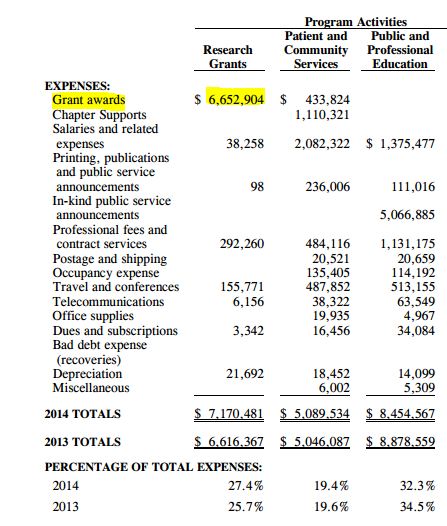- Home
- Activism
- Crime & Courts
- Economics
- Education
- Environment & Climate Change
- Examiner.com Archives
- Gun Control
- Healthcare
- History
- Human Interest / Inspirational
- LGBT Issues
- Politics
- Racial Issues
- Rants / Op-Eds
- Religion
- Right-Wing Hatred
- Social Issues
- States Issues
- The War on Drugs
- Veterans Issues
- Weird News
- Women's Issues
- World News
Only a fraction of ALS donations actually go to research
The Ice Bucket Challenge is based on raising money to fund research to find a cure for Amyotrophic Lateral Sclerosis, or ALS.
How does the ALS Association (ALSA) use the donations they so generously receive? The ALSA discloses in their financial documents that only 27% of the money donated to find a cure is actually used to fund research.
ALSA’s financial disclosure documents are available on their website. Initially they offer this colorful and cheerful graph:
That’s right, only 27% of donations actually go towards research! Over $1.9 million a year goes towards paying the salaries of individuals who work for the ALSA and nearly $4 million goes towards fund raising. Meaning they spend donation money, in hopes of raising more donations!
If one wishes to break down the numbers they find this in the 2014 financial statement:
The true amount spent on research is $7.17 million out of $26.2 million, or is it? Digging more yields more results:
The ALSA actually only spent $6.6 million on research, and not $7.2 as they reported in their colorful graph. $292,000 went towards ‘professional fees’ and ‘contract services.’ $155,000 went towards travel expenses. Shouldn’t that money be detailed under the $1.9 million of administration?
One may also find it curious that 32% of total revenue is spent on ‘public and professional education’, or in other words raising awareness. It could be argued that raising awareness falls under the category of fundraising, as one has to be aware of the disease to donate, no? However then the graph would say 46% towards fundraising, and not 14%. The decision to report spending in this manner is by no means random.
So while the ALSA brags that they’ve raised $70 million since the inception of the Ice Bucket Challenge the public has a right to know that only around $17.5 million of that money will go towards finding a cure.



